The front suspension is independent, MacPherson type linkage spring, with telescopic shock absorber struts, coiled coil springs, wishbones, torsion-type anti-roll bar.
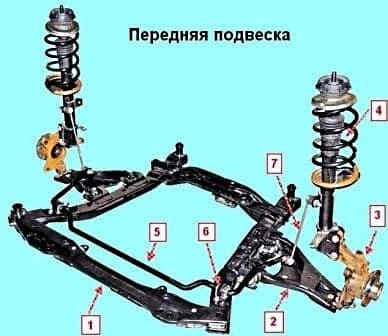
The main elements of the front suspension are telescopic shock absorber struts, which combine the functions of the telescopic element of the guide mechanism and the damping element of the vertical vibrations of the wheel relative to the body.
The shock absorber struts are assembled with coil springs, compression buffers with protective covers and upper supports with thrust bearings.
The load on the car body is transmitted through the upper support.
The shock absorber strut is connected to the suspension arm through the steering knuckle with a ball joint.
The anti-roll bar is connected to the front suspension subframe with two brackets through rubber cushions, and with shock absorber struts, anti-roll bars.
The suspension arms are attached to the front suspension subframe through rubber-metal hinges.
The front wheel hubs are mounted on non-adjustable double row angular contact ball bearings.
Removing the subframe is covered in the article – Removing the subframe of a Renault Duster car
Replacing the front wheel hub bearing is discussed in the article - Replacing the front wheel hub bearing Renault Duster.
Let's consider replacing the rest of the suspension units.
Removing the anti-roll bar
We remove the stabilizer strut and replace it when its rod is deformed, play appears in its ball joints, damage to the protective covers of the hinges and when repairing other suspension elements.
We carry out work on a flat area.
We hang the front of the car - both front wheels, because when hanging only one wheel, the stabilizer presses the suspension elements up, which prevents dismantling.
Remove the wheel.

Using a 16 wrench, unscrew the nut securing the pin of the upper hinge of the stabilizer strut, holding the hexagon 5 from turning

Remove your finger from the shock strut bracket hole
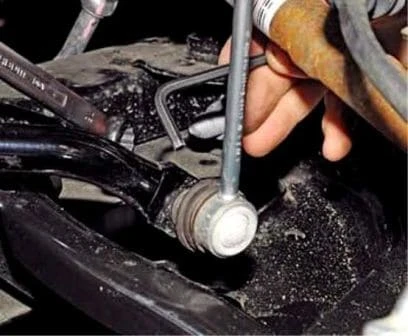
In the same way, we unscrew the nut securing the pin of the lower hinge of the rack to the stabilizer bar
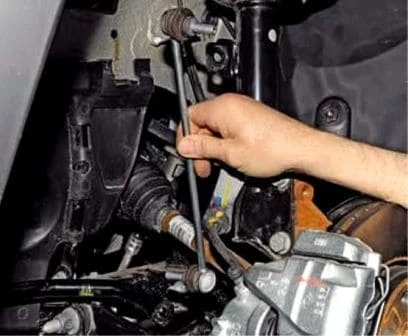
Remove the anti-roll bar
Install the rack in reverse order. Tighten the stabilizer strut pin nuts with a torque of 35 Nm.
Replacing the stabilizer bar pads
We change the rubber pads for attaching the rod to the front suspension subframe if they break and are significantly worn, as a result of which there is a backlash in the connection of the parts.
We carry out work on a flat area.
We hang the front of the car - both front wheels, because when hanging only one wheel, the stabilizer presses the suspension elements up, which prevents dismantling.
The work is shown on the left cushion of the stabilizer bar, we remove the right cushion in the same way.
Remove the wheel.
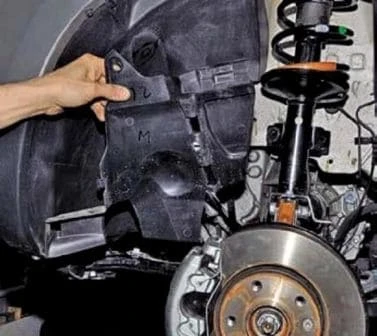
We remove the mudguard of the engine compartment (article - Removing the protection of the engine, wheel arch liners and mudguards Renault Duster)

With a 13 head, unscrew the two bolts securing the stabilizer bar bracket to the subframe
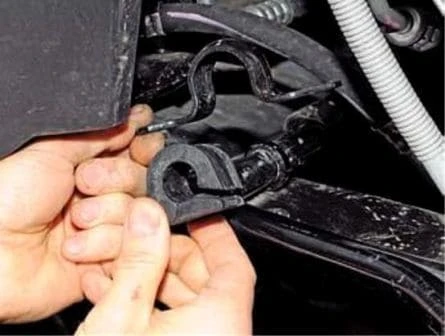
Remove the bracket and the stabilizer bar cushion
Install the cushion and stabilizer bracket in reverse order.
When installing, please note that the slot on the cushion should be directed forward (in the direction of the vehicle).
Tighten the bracket mounting bolts to a torque of 25 Nm.
Removing the anti-roll bar
We remove the anti-roll bar for replacement if it is deformed or broken.
We carry out work on a viewing ditch or overpass.
Disconnect the stabilizer struts from the rod and remove the rod cushions, as described above.
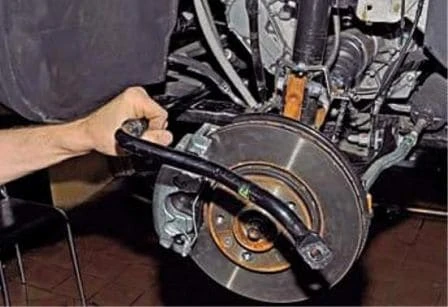
Bring the bar to the side
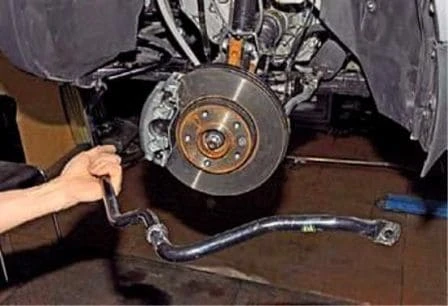
Removing the barbell
Install the bar in reverse order.
Removing the shock strut and disassembling it
We remove and disassemble the shock strut when it is necessary to replace its spring, upper support, support bearing, compression stroke buffer with a protective cover or shock absorber.
Remove the shock strut on a flat area.
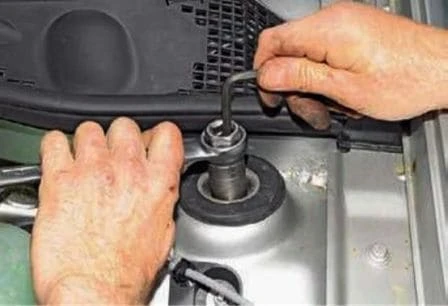
We open the hood and a high head at 21 with an external hexagon (or, grabbing the outer surface of the head with a tubular wrench), loosen the nut of the upper shock mount, keeping the shock absorber rod from turning with a hexagon at 6.
Remove the wheel and fix the car on the stand.

With a head of 10, unscrew the bolt securing the wire holder for the wheel speed sensor

Remove the holder with the wiring harness from the rack
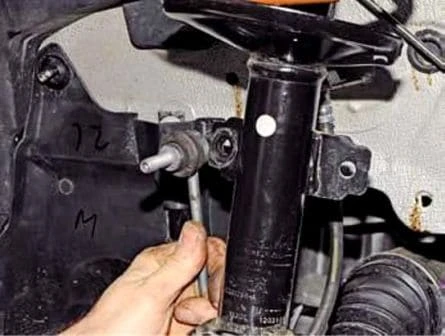
Disconnect the stabilizer bar from the shock strut bracket as described above
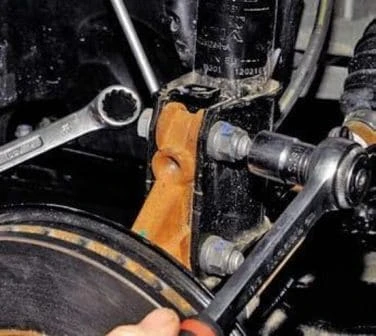
With a head of 18, we unscrew the nut of the bolt of the upper mount of the rack to the steering knuckle, holding the bolt from turning
We also unscrew the nut of the lower rack mounting bolt. We take out the bolts or knock them out with a drift.
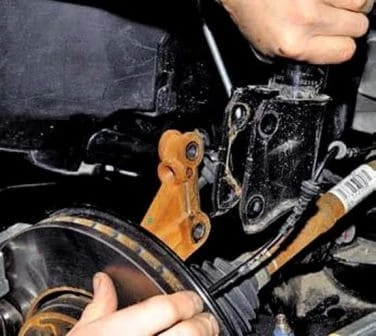
Remove the rack from the steering knuckle.

Holding the rack from falling, finally unscrew the nut of its upper fastening
Remove the shock strut

Remove the rubber-metal support washer of the upper shock mount

Compress the spring with ties
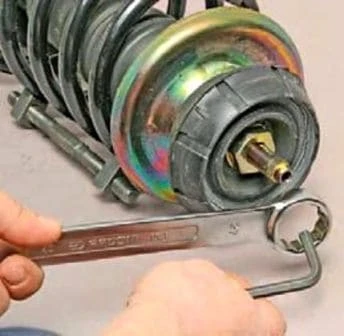
Compressing the spring, use a 27 spanner wrench to unscrew the nut securing the upper support, holding the stem with a hexagon 6

Remove the stand support
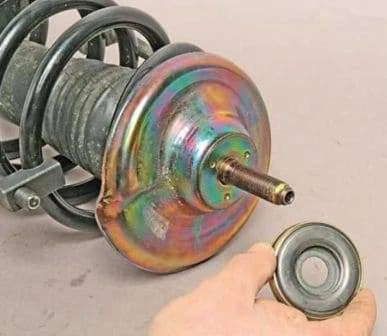
Remove the bearing of the upper support

Remove the upper spring cup
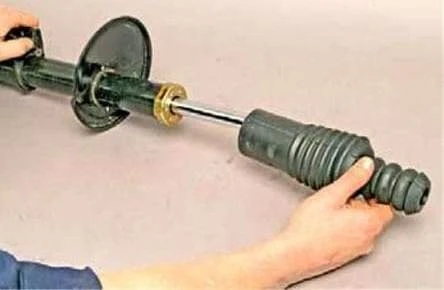
Remove the compression stroke buffer with a protective cover
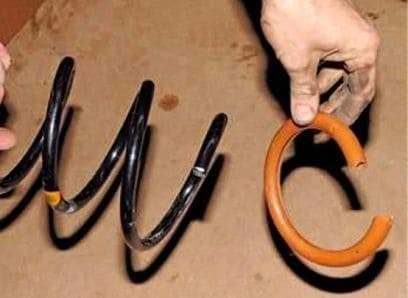
Remove the spring case
We assemble and install the shock strut in the reverse order.

We install the spring so that its lower coil rests against the protrusion of the lower cup of the spring welded to the rack body
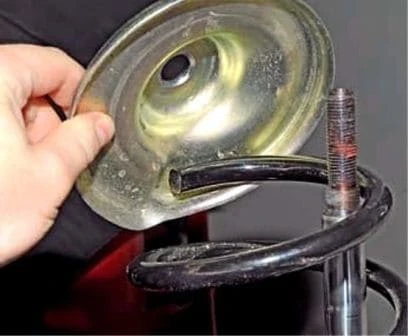
And so that the upper coil rests against the stamping of the upper cup of the spring.
Tighten the upper support nut with a torque of 62 Nm.
Removing the lever and ball joint
We remove the lever to replace the ball joint or the lever itself if it is deformed, if there are cracks in the metal, or if the silent blocks of the lever are damaged (rupture, peeling of rubber).
We carry out work on a viewing ditch or overpass.
We hang the front of the car - both front wheels, since when hanging only one wheel, the anti-roll bar prevents the lever from being dismantled, pushing the suspension elements up.
Remove the front wheel.

Using an 18 wrench, unscrew the nut securing the ball joint pin until it rests against the body of the outer hinge of the wheel drive.
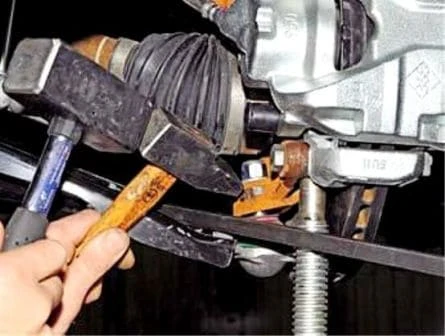
We substitute an adjustable stop under the steering knuckle.
With a mounting spatula, we press the lever with the ball joint down while simultaneously striking with a hammer through the spacer on the eye of the steering knuckle, pressing the finger of the ball joint out of the eye.
Then, as the ball joint pin comes out of the steering knuckle eye, unscrew the nutku.
Remove the ball joint pin from the steering knuckle hole
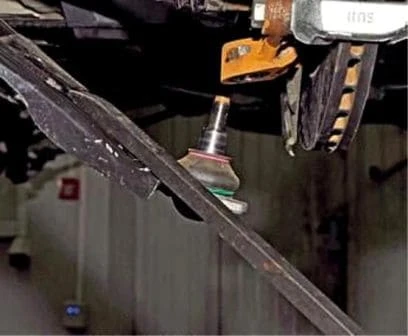
Using a 21 spanner wrench, unscrew the nut of the bolt of the front mounting of the lever, holding the bolt with the head at 21.

Remove the bolt or knock it out with a mandrel.

We also unscrew the nut of the lever rear mounting bolt and remove the bolt
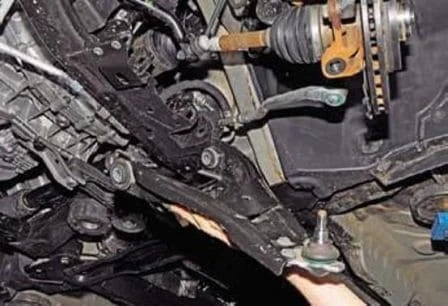
Remove the suspension arm
Install the lever in reverse order.
We finally tighten the nuts of the bolts of the lever to the subframe with a torque of 62 Nm.
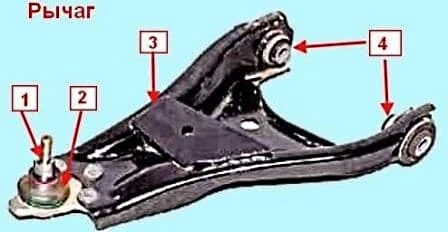
The ball joint is not supplied separately by the manufacturer as spare parts and is replaced together with the lever.
However, it can be removed from the lever and replaced with a similar support from other manufacturers.
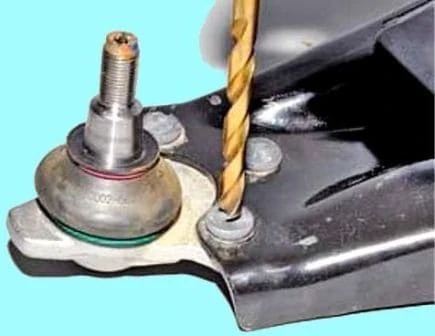
To do this, we drill out the heads of the rivets that secure the body of the ball joint, and fasten it with bolts and nuts.





